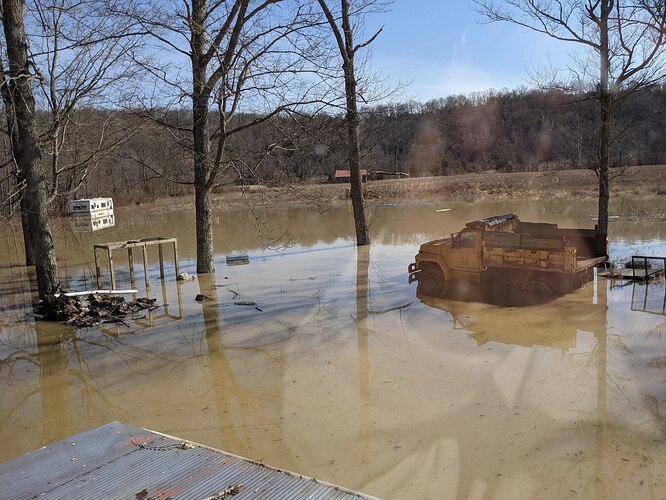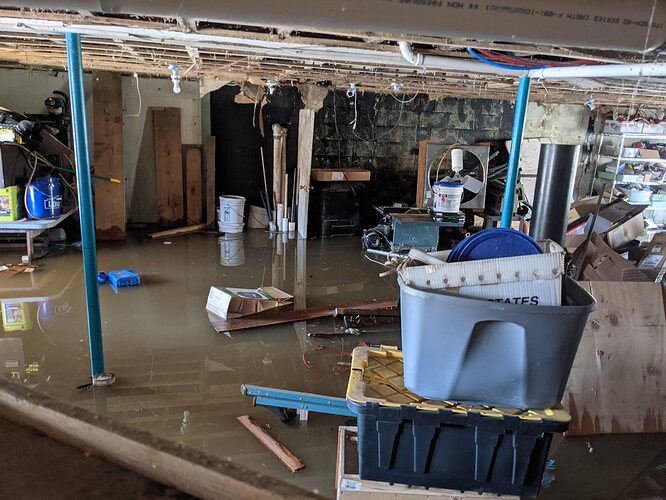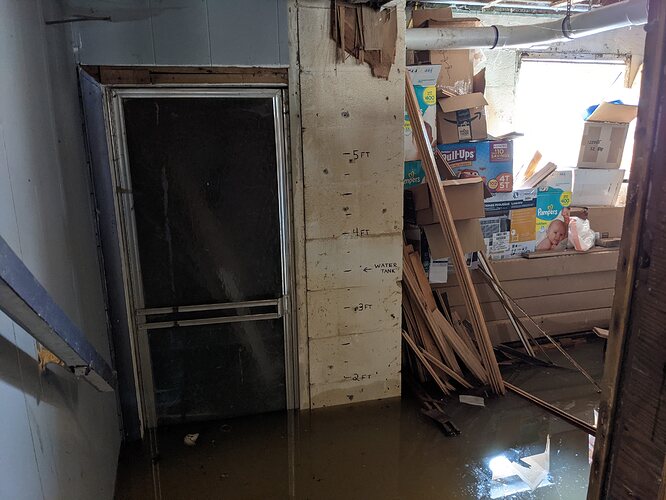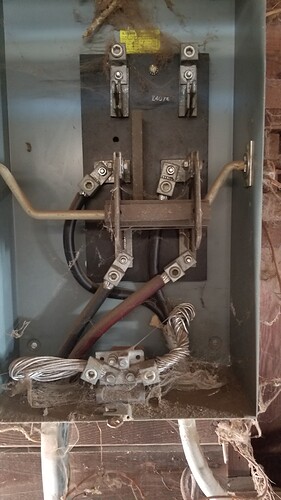Hey Chris, any updated information and pictures?
Hi Bill, we’re still working on improvements, and I’m moving on to more mechanical projects as well.
My Toyota truck blew a head gasket last summer, so I rebuilt the top end over Christmas break. It runs great now. If anyone has that particular engine, this is an excellent guide to head gasket replacement:
I also put a new muffler on it, and it is a lot quieter. I am thrilled to have a working truck again.
The other project over the break was a kitchen island. We had been using a dresser we got for free with our bed frame, but this is much better:
Built using two spare base cabinets and a countertop from IKEA. The shelves sort of match, they are “paint-grade” panels from Lowes, which have a lovely butcher-block pattern to them.
At the same time, all the food moved out of the kitchen into the laundry/pantry, which makes the kitchen much more spacious.
The basement is becoming my workshop, which has been through a couple rounds of organizing, and needs a couple more. Projects for the spring include fixing up our old Honda van, building a greenhouse, getting a couple tons of firewood cut and stacked (in the greenhouse!), getting a garden started, putting a new roof on the house, rebuilding the old MF150 tractor, and graveling some of the driveway.
At Earth Tools we are currently going through a bit of a transition, as we learn to collect sales tax out of state, and upgrade our accounting software to something beyond Quickbooks. All this is right in my lap. I’m excited to be able to make this shift happen, but it is eating up a ton of my attention right now. Hopefully when things settle down by later this year I will be able to focus on the homestead more.
Nice work Chris and family, love the countertops and flooring,
really sets it off. Pepe
With a project list like that you will need to invite @JocundJake over to get it done this spring. The way he starts up that gasifer on the video you just might finish before summer is over.
The house sure does look amazing though. It is hard to believe it is the same house you bought just a short time ago.
Thanks for the update Chris.
We just need to see how big the little one is now.
Kids sure do affect how one prioritizes.
Wow, haven’t updated this in forever… Mainly wanted to post two things:
#1. We got flooded badly this year. I knew it was a possibility, we are in a floodplain.
We were unable to get out for 8 days. No major damage, I got all the vehicles moved and the basement items raised up. I was thankful for the above-ground water tanks which as you can see remained clean and above the water level.
#2. Although we never lost power, I fully expected to, and was relatively unprepared for it. My little 800 watt 2-stroke generator doesn’t have the guts to start up any of our 3 chest freezers or the fridge. And, my wife can’t pull start it reliably; they are a bit finicky and I’m not sure there’s a compression release.
So, I decided to resolve the situation last week. After a lot of research, I settled on the Harbor Freight Predator 3500 inverter generator.
It is based on their excellent Honda-clone 212cc 6.5 hp Predator engine, which looks thoroughly gasifier friendly. It pull starts very easily, and has electric start. Major wife points for that. The inverter puts out a very clean sine wave and starts the freezers effortlessly even on ECO mode. Extremely quiet, in fact one video I saw tested it as quieter than the Honda 2000i. Very nice tone to my ear, lower pitch and not a “screamer” at all. We can’t hear it running in the house.
It won’t do 220v so the stove and water heater will go offline. We have a propane grill and campstove for cooking, and of course the woodstove. Water heating on wood is still on the list somewhere.
I’ve been re-reading some good small engine threads here on DOW, which I will share.
hey Chris nice to hear from you.
Will you just run cords around the house or do a dedicated back up panel and generator plug? I know I never regretted it as it made things much more user friendly in case I was not there.
reference for others: https://www.homedepot.com/p/GE-60-Amp-8-Space-120-240V-Single-Phase-3-Wire-Surface-Mount-NEMA-1-Generator-Panel-TM860SCUGEN/203393784
Hi David, I was hoping you would chime in! Still enjoying your last tip-off to the ceramic water filters, they’re perfect for us and our drinking water taste is the envy of my entire family.
Of course I’m inclined to wire the panel, but since this doesn’t do 240 volts I’m not sure how. Just leave one leg unhooked? Wire it for 240 in case I get a bigger generator later?
Hey ChrisS, good deal you’ve got on board the inverter generator train.
Once you have . . . .you really learn to hate synchronous RPM screamers.
Best plan on a Harbor Freight Chinese is to buy at least TWO.
Then worst case: one can be the spare parts for the other.
Best case: when your needs are low you only run one.
I do not see parallel’ing capability offered on this? I thought I’d seen that demo set-up in the store on these?
Two together would give you a solid 6000 watts. Just what you’d need for a 120vac suitcase multi-process welder like my new Forney 140. Made-in-Italy.
And two you can then point-of-need spread out and about the homestead.
Can woodgas/chargas develop risk one first; and still have wife settling capability.
Regards
Steve unruh
Definitely a second one for backup and parallel use would be excellent. They do have that paralleling capability. I do also have an eye to building a new house using these generators.
Just make sure you buy the generator panel that unhooks both hots and the neutral (neutral wire has a lug on the input breaker ) then wire the 120 generator into both hots on the generator sides and two seperate hots on the house side. That way the generator is completely isolated and if you move on to a 220 down the road it’s easy. I ran both hots to the outside genny plug and made a custom cord for my generator to plug cord that jumped both hots in the cord.
Glad the filter is working for you. Mine stayed with the house when we sold it. Hopefully the new well is good and I wont need it.
Cheers, David
Chris, when I was 0 to about 6 years old, we lived on flood planes. Every year the house was surrounded by water and the basement was a swimming pool. It was a really old farm house so the basement never had anything of value in it. I think the floor was dirt. The only way in and out was on a tractor. Even the road would be under water.
Thank you for posting the generator information and the links. I didn’t know the details of this model. I want one. When I was still going to consignment auctions, I noticed that a good number of inverter generators were showing up in the piles of stuff I shop for (non-running stuff). Interestingly, Honda inverter generators were with them, along with other models. I never recall seeing a HF in the piles of stuff (I could be wrong). But you might want to keep an eye out for non-running no longer wanted generator of the model you have. Could be a source of parts.
I have an electrical engineering background and I just don’t understand why an affordable, durable invertor has proved so difficult to manufacture and bring to market. I know what goes into them and it seems like willful negligence to save $30 under sizing the switching transistors and choosing cheap capacitors. But that’s where we are…
Inverter generators are nice for efficiency and people find them very robust, but you can’t shoehorn a battery in there. So you are wed to a constantly running engine whenever you want your home outlets and appliances to be powered and the engine has to be sized to peak power needs.
A generator that charges a battery bank which then drives an invertor gives a lot of flexibility. Lithium Ion (but not lead-acid) are great for surge currents so the engine can be sized to average power rather than peak. And depending on bank sizing, you might be able to run on batteries say overnight when power needs are low but not zero. Battery charging electronics are also pretty simple and robust, especially compared to invertors.
Lastly you might look at what power uses can avoid the inverter all together. Any DC appliances you can source would take pressure off the invertor(s), though they can be more expensive - I’m looking at you Grunfos well pump. Also consider “AC” appliances that are internally inverting and can handle DC without issue like certain induction tops, mini-splits/ACs. Those might run off batteries directly (though probably they’d want higher voltage than even a 48v pack).
Some research and care is needed if going that route but any high power, high surge devices that can dodge the inverter are a huge win. Many high efficiency appliances are geared for international markets and in order to handle 110v and 220v power systems end up converting whatever comes in via the plug to 48v DC internally. Many can accept 48v DC directly or be modified to do the same. That’s a more advanced topic but worth it many cases. Take care that any DC circuits are handled properly and are up to code. Generally 48v and under are governed lightly.
I would disagree on inverter longevity. I have a trace inverter that was a daily unit for 20 plus years and still runs occasionally for tools. My own daily user magnum inverter is 12 years old daily running now powering our whole work site. Usually it’s the control boards that go and they are all field serviceable or bolt off the wall and ship to regional dealers. I have found inverters and batteries far more reliable then generators.
Chis it is probably a little late but before I bought a second generator I would definitely look around for a used pto generator. If you can find some dairy farms that are going out of business they will most definitely have one around 15kw which would easly be powered by the tractors you have on that property and would provide enough current for your entire home at 240 the farms need them to run the compressors to keep the milk cold.
I picked up mine from a tool truck of all places for $400 IIRC. Old unit but it works perfectly.
As to hooking up the generator to the power panel you have two choices old school A B switch.
You wire the grid to A the generator to B and the panel to the center. This makes it impossible to back feed the grid.
Or you can get a modern hybrid inverter for a grid attached solar or wind power system with storage which is much more expensive.
You can wire a 120 generator into a 220 panel but you must turn off all the 220 loads first or bad things will happen.
There are two ways to do this first is wire the neutral to the panel neutral. Then wire one phase to the hot side of the generator and you will get every other breaker on the panel live. But any 220 breakers left on will only see one phase which is dangerous to a 220 motor so be sure to shut off those breakers.
The other option is to wire the neutral to the panel neutral than jumper both phases in the panel to the hot line of 120 on the generator. Now you again have to make sure all 220 breakers are turned off and then you can power all the 120 outlets in the panel. But a 220 load wll see a dead short which would be bad in this configuration. My advice would be to split all the 220 loads into their own subpanel that is disconnected when you turn on the generator in either case. I hadn’t thought of installing a generator in that configuration until I saw it done by a solar installer at an off grid system. In that case there where no 220 loads on the system anyway so it wasn’t a concern.
Yup the typical thing that kills electronics is a spike on the incoming line voltage like the power company uses to clear limbs or a under volatile on the incoming line. My experience has also been that all the electronics on a standalone inverter are more reliable. The only issue I have see with inverters has been heat related from over loading or not providing good air flow for cooling.
One thing to keep in mind expecally with lithium is that you need a way to disconnect the DC loads at under voltage or you risk damaging the battery pack. I have a dead dewalt 20volt lithium battery pack because I used it to charce my cell phone in a power outage and the phone charger at 5 volts drained the pack so low it won’t recharge. The last time I saw this I took apart the pack and found damaged cells from over discharging. Direct DC loads still need to be controlled by the battery management system. Lead acid or Edison batteries would be more forgiving in that respect I guess.
DanA,
I am not disagreeing with you . . . .
but a saving-grace in Grid-out, for those Grid spoiled is to take away their 240 capabilities.
That means the electric hot water heater.
The electric clothes drier.
The kitchen range and oven.
Give them 240 wattage and they never learn loads management. Loads scheduling.
They never learn deamnds management when YOU: the system capabilities enslaved; continue to provide their . . . . un-thoughtfulness.
And when YOU can’t fuel input-wise keep them supplied; then they look at you as the not-loving-me-enough, failure.
Grid-down mean going cold turkey. Practice runs for going true no-Grid.
Yep. Good 'ol big ones are cheap at penny’s to the dollar out their. The fuel never was; never is cheap. Even wood to feed a 10-15 KW electrical system strips out a wood shed fast.
These inverter-generators when they get consumer oblivious overloaded: they stop all AC output. Just sit there running at Eco idle mode until manually reset. Or, shut down restarted, with reduced loading within their capabilities.
The oblivious Learn. Learn after 2-3-4 of these cycles just what they can use. Without the equipment damaging. No need to nag them. Let the circumstances do that.
Have 240 generating capability ONLY wire in the deep well pump. That’s it. ( Pssst. With a secret welder plug)
Just been my peoples experiences man.
Steve Unruh
Doesn’t sound like chris is going down the 240 road steve just some sensible backup. I stick by wiring in a generator panel though as it makes things so much more user friendly without going all soft and easy. My new house will be horribly soft with a large dedicated load panel, a 240 grid connected inverter, and a large array with battery backup… downright decadent!
My new house will be horribly soft with a large dedicated load panel, a 240 grid connected inverter, and a large array with battery backup… downright decadent!






